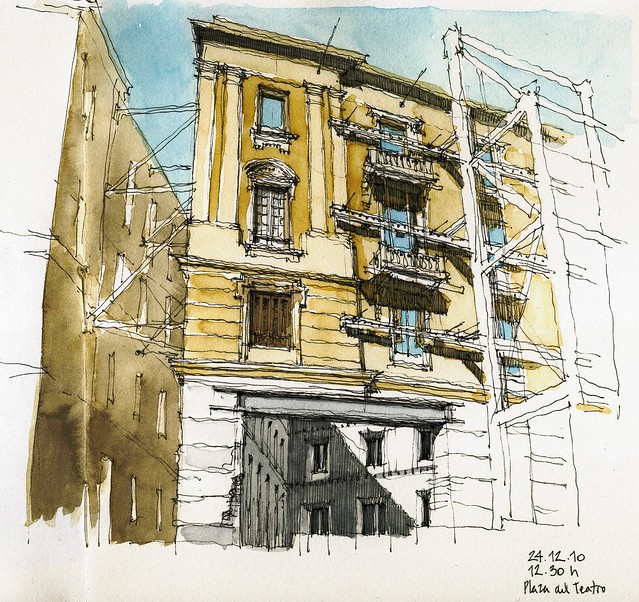
Grigori Potëmkin -pronúnciese Patiomkin- era un aristócrata ruso que, entre otras ocupaciones, además de militar y estadista, era favorito de la zarina Catalina la Grande. Su nombre ha pasado a la posterioridad gracias a la película que el director de cine Serguéi Eisenstein le dedicó al célebre acorazado que fue bautizado en su nombre. Pero también se le recuerda por otra actividad: la creación de ciudades ficticias a lo largo del recorrido que había de seguir el cortejo de la zarina por la península de Crimea, con el único fin de hacer creer a Catalina en la prosperidad de los territorios que atravesaba. En efecto, las poblaciones de bellas fachadas que se vislumbraban a través de la ventanilla eran sólo un decorado, un maquillaje que ocultaba la realidad.
El arquitecto Adolf Loos recordaba esta faceta del príncipe ruso cuando definió a Viena como "ciudad potemkin", aludiendo a la rica ornamentación de las palaciegas fachadas del fin de siècle que, sin embargo, ocultaban vivendas de alquiler mucho más modestas de lo que cabría pensar contemplándolas desde fuera.
En los albores del siglo XXI observamos de nuevo la sombra de Potemkin proyectándose sobre nuestra arquitectura heredada. Arquitecturas que han sido privadas de su sustancia edificada, vaciadas de contenido, convirtiéndose en una simple cáscara, a través de cuyas aberturas vemos el azul del cielo...
Un edificio es un sistema coherente, en el que la fachada es uno más de sus elementos. ¿Será coherente la relación entre la piel del nuevo edificio y su interior?
Grigory Potemkin -pronounced Patyomkin- was a Russian aristocrat who, among other occupations, as well as military and statesman, was a favorite of the Empress Catherine the Great. His name became famous thanks to the film director Sergei Eisenstein dedicated to the famous battleship that was baptized in his name. But he is also remembered for other activities: the creation of fictitious cities along the route to be followed by the cortege of the Empress by the Crimean peninsula, with the sole purpose of making Catherina believe in the prosperity of the territories she was traveling through. Indeed, populations of beautiful facades that were visible through the window was just a decoration, a make-up concealing reality.
The architect Adolf Loos recalled this facet of the Russian prince to Vienna when he defined it as "Potemkin City", referring to the rich ornamentation of the palace facades of the fin de siècle that, however, hid rented flats more modest than one might think, contemplating them from the outside.
In the twenty-first century we again see the shadow of prince Potemkin projected on our inherited architecture. Architectures that have been deprived of its built substance, empty of all content, becoming just a mere shell, through whose openings we see the blue sky ...
A building is a coherent system in which the facade is just one of its elements. Will the relationship between the skin of the new building and its interior be consistent?

lo bueno es que ademas de disfrutar con los dibujos, me culturizo, me ha encantado el tío este,...el Potemkin
ResponderEliminarPues sí, Juan Mª; todo un personaje, Potemkin. Qué gran concejal de urbanismo se ha perdido la España moderna...
EliminarEnchanting drawings, Luis, and such an interesting subject! I didn't know of these fictitious cities due to Potemkin, yet I guess it's something that might have happened many times in authoritarian regimes. These buildings in Malaga, despite their essence of empty shells, are beautiful mainly for their close relationship with the sky! Have a nice week!
ResponderEliminarGrazie, Lucia! The sad point is what we are losing unnoticedly, sometimes to be replaced by bold constructions. Have a nice week you too!
EliminarMuy interesante lo del señor Potemkin, y tremenda tu reflexión sobre las ciudades envoltorio. Los dibujos, la gozada habitual.
ResponderEliminarGracias, Miguel. Asusta pensar qué habría podido hacer el amigo Grigori en nuestro país de haber vivido en esta época...
EliminarSensacionales dibujos, palabras muy interesantes e um titulo magnífico.
ResponderEliminarEnhorabuena Luis!
Muito obrigado, amigo Filipe!
EliminarLuis, si ya era seguidor de tus obras, ahora lo soy por partida doble y ya sabes porqué. Espero que me permitas usar en alguna ocasión estos dibujos (por supuesto citando tu autoría). Saludos y enhorabuena por no solo crear cosas hemosas, sino también implicarte, más aún con reflexiones tan interesantes como la del caso Potemkin, que desconocía por completo.
ResponderEliminarMuchas gracias, Anton, también doblemente, pues en cierta medida has sido tú el inspirador de estas reflexiones, como ya habrás advertido. Por supuesto que puedes usar mis dibujos si lo estimas oportuno, y por favor no dejes de suscitar debates que nos hagan detenernos a pensar.
EliminarYour sketches are beautiful and interesting, but I find your writing even more fascinating and educative.
ResponderEliminar